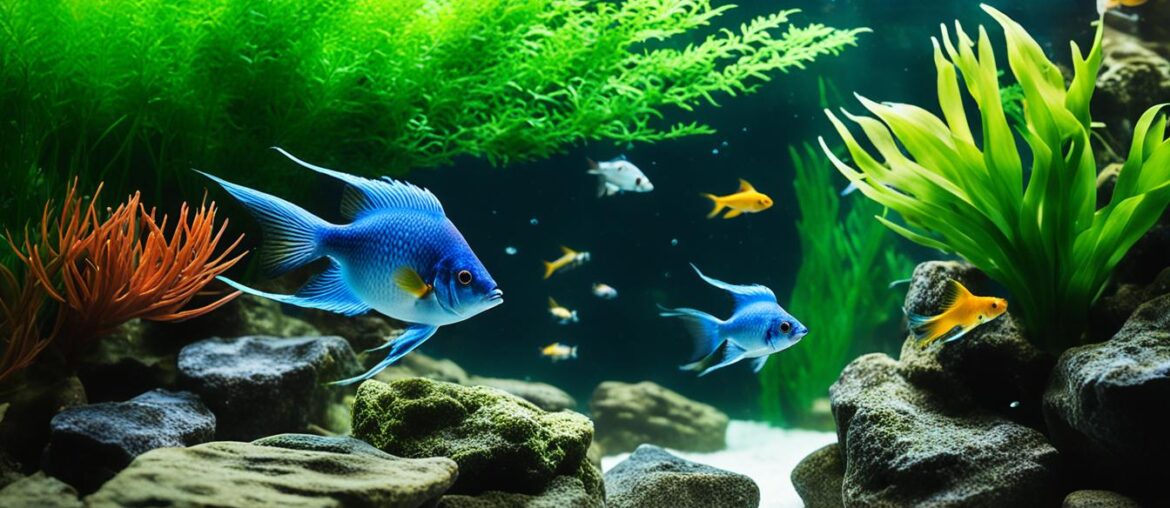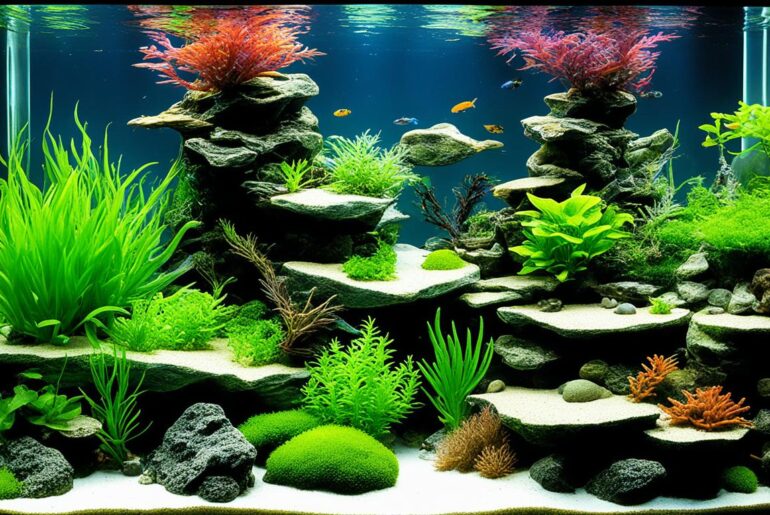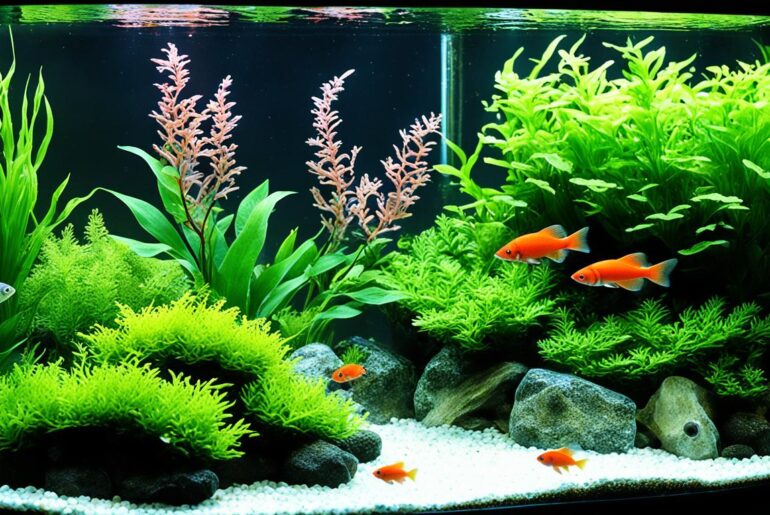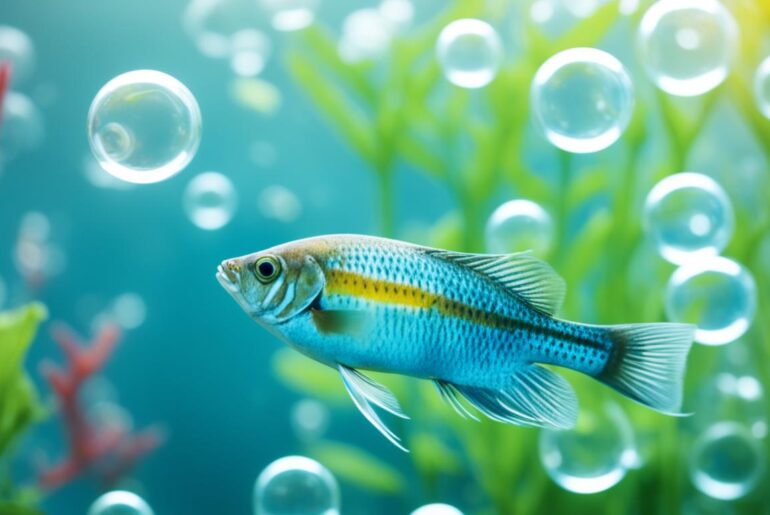As an avid aquarium enthusiast, I remember the excitement and anticipation of setting up my very first tank. I carefully chose the perfect aquarium, adorned it with vibrant plants and decorations, and eagerly brought home my new finned friends. But as I soon discovered, there was a crucial step I had overlooked – aquarium cycling.
Aquarium cycling, the process of establishing a biologically balanced environment for fish, is essential for their well-being. It involves introducing nitrifying bacteria that convert toxic ammonia into less harmful substances, ensuring a healthy nitrogen cycle that fosters optimal water quality.
I vividly recall the frustration and disappointment of losing a few precious fish during the early stages of my aquarium journey. It was then that I realized the importance of cycling and the need to provide a stable and safe habitat for my aquatic companions.
In this article, I will share with you 5 natural ways to cycle your aquarium that are perfect for beginners. These methods will not only help you create a thriving aquatic ecosystem but also provide a fulfilling experience as you watch your fish flourish in their new home.
Key Takeaways:
- Aquarium cycling is crucial for creating a healthy environment for fish.
- Introducing nitrifying bacteria helps regulate the nitrogen cycle and convert toxic ammonia.
- Proper cycling methods are essential for beginners to ensure the well-being of their fish.
- By following natural cycling techniques, you can establish a biologically safe tank.
- Regular maintenance and monitoring are necessary for the long-term health of your aquarium.
What is Aquarium Cycling?
Aquarium cycling is the process of creating a biologically safe environment for fish in a new tank. It involves introducing nitrifying bacteria into the aquarium to regulate the nitrogen cycle. The nitrogen cycle is the essential biological process that converts toxic ammonia, produced by fish waste, into less harmful substances such as nitrite and nitrate.
The nitrogen cycle is crucial for maintaining water quality and providing a healthy environment for fish to live in. Let’s take a closer look at each stage of the nitrogen cycle:
- Ammonia: Fish excrete waste, releasing ammonia into the water. Ammonia is highly toxic to fish and can be deadly in high concentrations.
- Nitrite: Nitrifying bacteria, such as Nitrosomonas, convert ammonia into nitrite through a process known as nitrification. Nitrite is still harmful to fish but less toxic than ammonia.
- Nitrate: Another group of nitrifying bacteria, called Nitrobacter, convert nitrite into nitrate. Nitrate is the least toxic form of nitrogen and can be safely tolerated by most fish in low to moderate concentrations.
A healthy aquarium requires a well-established nitrogen cycle to efficiently remove ammonia and nitrite, while maintaining a manageable level of nitrate. This is achieved by introducing nitrifying bacteria into the tank, which colonize the filter media and other surfaces. These beneficial bacteria play a vital role in breaking down nitrogen compounds and converting them from toxic to non-toxic forms.
By establishing a properly cycled aquarium, you create a stable and sustainable ecosystem for your fish, promoting their overall health and well-being.
Why is Aquarium Cycling Necessary?
Aquariums need to be cycled to establish a healthy and stable environment for fish. In the absence of proper aquarium cycling, fish waste can lead to an ammonia buildup, which can be toxic to aquatic life. This is where nitrifying bacteria come into play. These beneficial bacteria grow in the biofilters of the aquarium and play a vital role in converting toxic ammonia into less harmful substances.
If an aquarium is not properly cycled, the biofilters will not be able to keep up with the ammonia levels, leading to an imbalance in water chemistry. The high levels of ammonia can be detrimental to the health of fish, causing stress, illness, and even fatalities. This condition is known as New Tank Syndrome.
By establishing a cycle in the aquarium, the nitrifying bacteria can effectively remove ammonia produced by fish waste, thereby maintaining a safe environment for the fish to thrive. Proper aquarium cycling is crucial to prevent ammonia buildup and protect the well-being of the fish in the tank.
It is essential to understand the importance of aquarium cycling and take the necessary steps to establish a healthy nitrogen cycle in the tank. This will create a stable ecosystem that supports the growth and well-being of your aquatic pets.
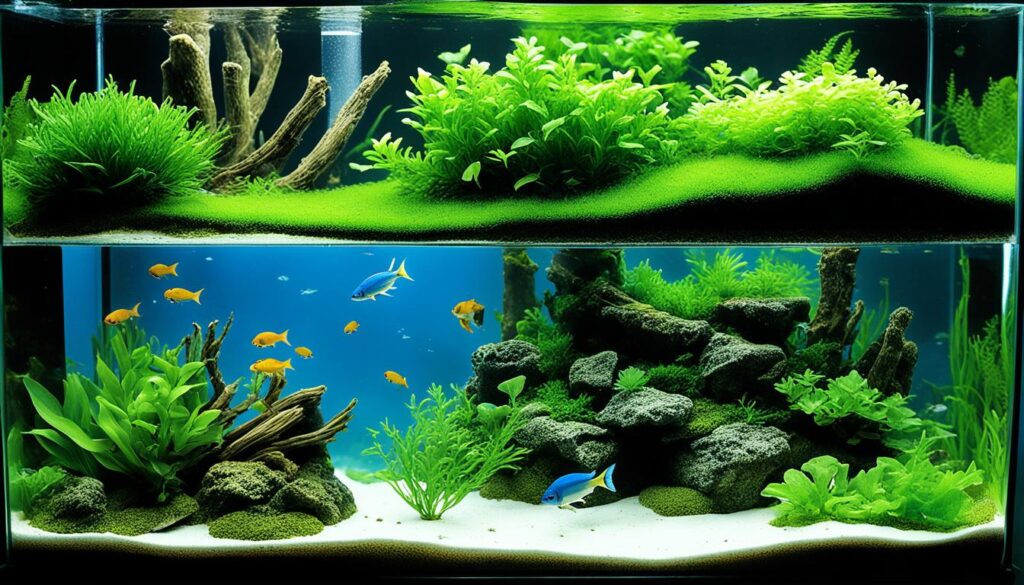
How Long Does Aquarium Cycling Take?
The duration of aquarium cycling can vary, typically taking around four to eight weeks. Several factors influence the process, including the tank’s size, water pH, and temperature. It is important to closely monitor water parameters, such as pH, temperature, ammonia, nitrite, and nitrate levels, to expedite the cycling process.
The cycling process can be assessed by observing the levels of ammonia and nitrite. As the cycle progresses, the ammonia level should decrease, followed by a reduction in nitrite. Once ammonia and nitrite levels reach zero and nitrate begins to appear, the cycle is considered complete.
To aid the cycling process, regular testing and monitoring of water parameters are crucial. Maintaining optimal conditions and providing a suitable environment for nitrifying bacteria will ensure a successful cycling process.
Additionally, variations in the cycling duration may depend on the type of biological filtration used, the number of nitrifying bacteria present, and the presence of live plants. Patience and dedicated maintenance are key to establishing a well-cycled aquarium that can provide a healthy and thriving habitat for fish to live in.
Steps to Cycle an Aquarium Without Fish
Cycling an aquarium without fish is a popular and humane method, suitable for beginners. By following these steps, you can effectively cycle your aquarium without subjecting any fish to unnecessary stress.
- Set up the tank’s components: Begin by assembling and installing all the necessary equipment, such as pumps, filters, and substrate, to create a suitable environment for the nitrogen cycle.
- Check the water’s pH: Before starting the cycling process, ensure that the water’s pH level is within the optimal range for the nitrogen cycle to occur. This will provide an ideal environment for the growth of beneficial bacteria.
- Add ammonia: To initiate the cycling process, add a source of ammonia to your tank. You can use household ammonia or commercial products specifically designed for aquarium cycling. This will serve as a food source for the beneficial bacteria.
- Monitor ammonia and nitrite levels: Test the ammonia and nitrite levels in your tank daily using test kits. This will help you gauge the progress of the nitrogen cycle. Ideally, you should see a rise in ammonia levels followed by an increase in nitrite levels.
- Check nitrate levels: As the beneficial bacteria start converting nitrite to nitrate, monitor the nitrate levels in your tank. This is an indicator that the cycling process is nearing completion.
- Introduce fish into the tank: Once the cycling process is complete and both ammonia and nitrite levels reach zero, the tank is ready for fish. Introduce them gradually to ensure that the environment is biologically prepared for their presence.
By following these steps, you can successfully cycle your aquarium without fish, creating a healthy and stable environment for your aquatic pets.
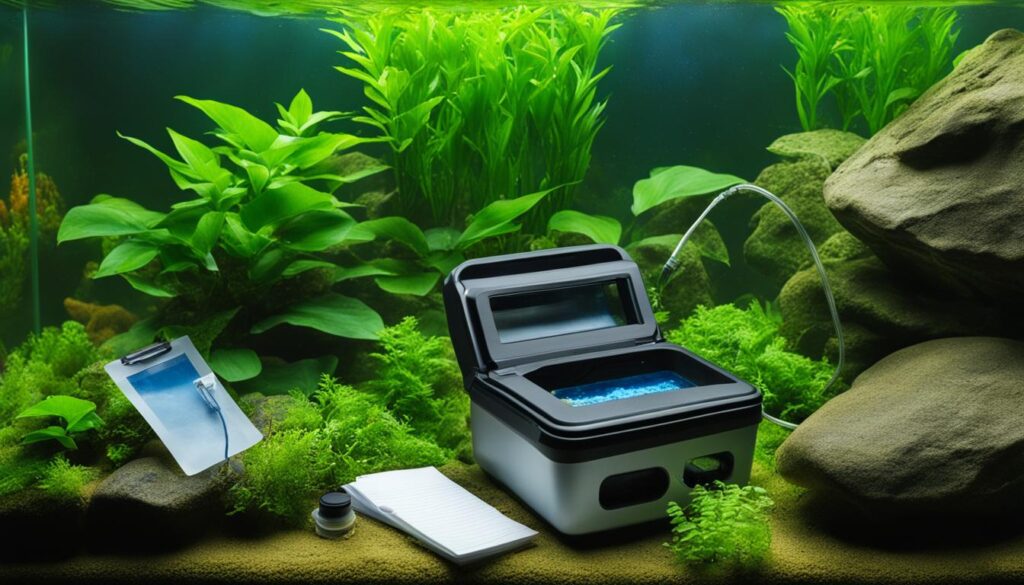
| Steps | Description |
|---|---|
| Set up the tank’s components | Assemble and install pumps, filters, and substrate |
| Check the water’s pH | Ensure the pH is within the optimal range for the nitrogen cycle |
| Add ammonia | Introduce a source of ammonia as a food source for bacteria |
| Monitor ammonia and nitrite levels | Test daily to track the progress of the nitrogen cycle |
| Check nitrate levels | Monitor nitrate levels to determine if the cycle is nearing completion |
| Introduce fish into the tank | Gradually introduce fish once ammonia and nitrite levels reach zero |
Steps to Cycle an Aquarium With Fish
Fish-in cycling is an alternative method to cycle an aquarium, which involves adding a small number of hardy fish to the tank at the beginning of the cycling process. Follow the steps below to successfully cycle your aquarium with fish:
- Set up the tank’s components: Start by assembling the necessary equipment, such as pumps, filters, and substrate. Ensure that everything is properly installed and functioning.
- Introduce a small number of hardy fish: Select a small number of fish species known for their hardiness, such as guppies or danios. Add them to the tank and acclimate them slowly to their new environment.
- Feed the fish sparingly: Minimize waste production by feeding your fish small amounts of food at regular intervals. Overfeeding can lead to an excess of ammonia and other toxins in the water.
- Perform frequent water changes: Regularly replace a portion of the aquarium water to maintain water quality. This helps dilute any accumulated toxins and prevents a sharp increase in ammonia levels.
- Use test kits to monitor toxin levels: Regularly test the water for ammonia and nitrite levels using reliable test kits. This will allow you to track the progress of the cycling process and ensure that it is proceeding in the right direction.
- Add fish gradually: Once toxin levels, particularly ammonia and nitrite, are near zero and the tank’s biological filtration is established, you can gradually introduce more fish to the tank. This gradual approach helps prevent any sudden spike in toxins that could harm the fish.
Remember to continue monitoring water parameters, performing regular maintenance, and providing proper care for your fish to maintain a healthy and thriving aquarium.
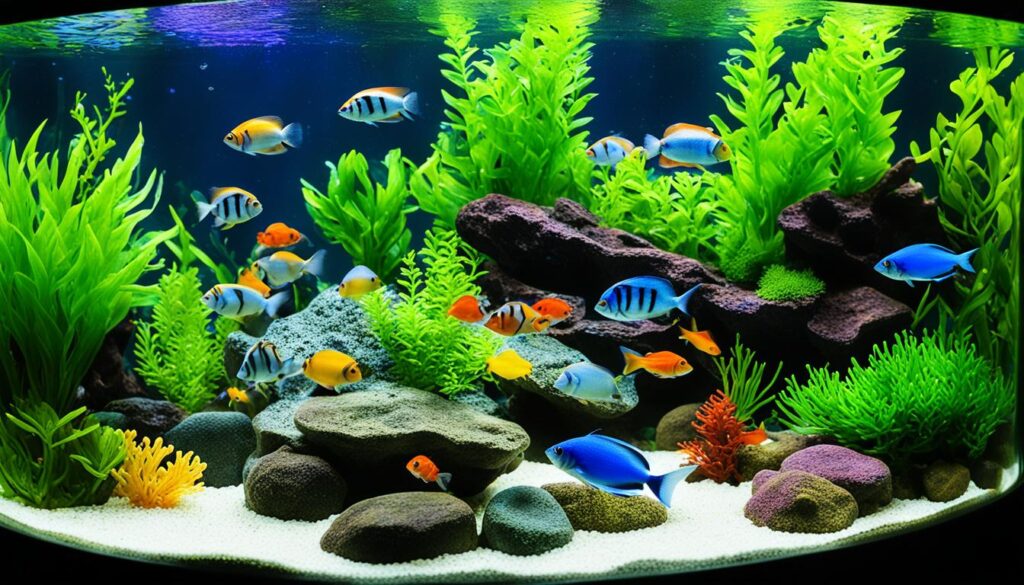
| Step | Description |
|---|---|
| 1 | Set up the tank’s components |
| 2 | Introduce a small number of hardy fish |
| 3 | Feed the fish sparingly |
| 4 | Perform frequent water changes |
| 5 | Use test kits to monitor toxin levels |
| 6 | Add fish gradually |
Steps to Cycle an Aquarium With Plants
Cycling an aquarium with live plants can create a natural ecosystem and provide additional benefits. By incorporating plants into your tank, you not only enhance its aesthetic appeal but also establish a balanced and healthy environment for your fish. Follow these steps to cycle an aquarium with plants:
1. Set up the tank’s components
To begin, set up the necessary components of your tank, including pumps, filters, and substrate. These elements create the foundation for your aquatic plants to thrive and contribute to the overall cycling process.
2. Add live aquarium plants
Introduce live aquarium plants into your tank. Choose a variety of species that are suitable for your tank size and water conditions. Live plants not only add beauty to your aquarium but also help to absorb excess nutrients and provide oxygen. They act as natural filters, contributing to the cycling process by removing toxins from the water.
3. Provide good lighting and substrate
Ensure that your plants receive adequate lighting and choose a suitable substrate for their growth. Most aquarium plants require good lighting conditions to photosynthesize effectively. Invest in quality aquarium lights that provide the right spectrum for plant growth. Additionally, choose a nutrient-rich substrate that supports root development and nutrient uptake.
4. Test the water for ammonia and nitrites
Regularly test the water parameters, specifically for ammonia and nitrite levels. Cycling with plants can help to minimize the presence of these toxins, but it’s important to monitor their levels nonetheless. Use a reliable water testing kit to ensure that the water conditions remain suitable for both your plants and fish.
5. Add fish gradually when toxin levels are near zero
Once the ammonia and nitrite levels in the water are close to zero, it indicates that the cycling process is well underway. At this stage, it is safe to introduce fish into your tank. Start by adding a small number of fish and gradually increase the population over time. Monitor the water parameters closely to ensure that the tank continues to support a healthy and balanced ecosystem.
6. Monitor water parameters and continue tank maintenance
Keep a close eye on the water parameters, including ammonia, nitrite, nitrate, and pH levels. Regularly test the water to ensure that it remains within the appropriate range for the well-being of your fish and plants. Perform routine tank maintenance, such as water changes and substrate cleaning, to keep the aquarium clean and balanced.
By following these steps, you can successfully cycle your aquarium with plants, creating a vibrant and sustainable aquatic environment for your fish to thrive in.
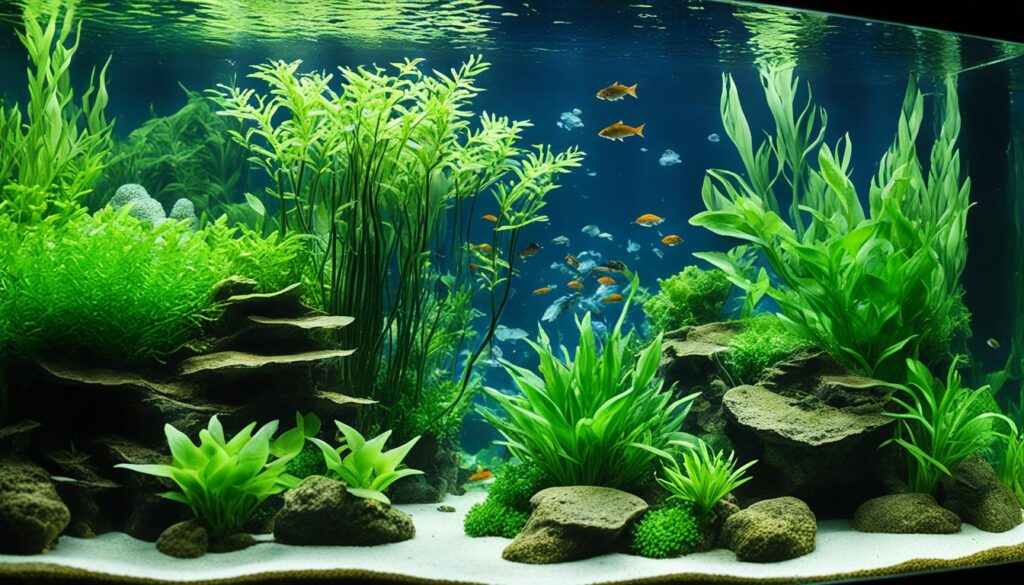
Maintaining a Cycled Aquarium
Once an aquarium has cycled, I must ensure that I maintain the water quality and conditions to ensure the well-being of my fish. This involves regular water testing for ammonia, nitrite, and nitrate levels, performing periodic water changes to maintain water parameters, properly feeding my fish, and conducting regular tank maintenance, such as cleaning filters and removing debris.
Regular water testing is crucial in a cycled aquarium to monitor the levels of ammonia, nitrite, and nitrate. This helps me ensure that the water is free from harmful toxins and within the optimal range for my fish. By using reliable test kits specifically designed for aquarium use, I can easily measure these parameters and take appropriate actions.
To maintain water parameters, I perform regular water changes. This involves removing a portion of the aquarium water and replacing it with clean, dechlorinated water. Regular water changes help dilute any accumulated toxins and maintain stable water conditions for my fish. The frequency and volume of water changes may vary based on the specific needs of my aquarium and fish species.
Proper fish feeding is also essential in maintaining a cycled aquarium. I make sure to feed my fish an appropriate diet and avoid overfeeding. Overfeeding can lead to excess waste and increased toxin levels in the water. By following the recommended feeding guidelines for my fish species and observing their behavior, I can ensure they receive the nutrients they need without compromising water quality.
Regular tank maintenance is another crucial aspect of maintaining a cycled aquarium. This includes cleaning filters, removing debris, and ensuring adequate water flow. Filters play a vital role in removing physical and chemical impurities from the water, so it’s important to clean or replace filter media as recommended by the manufacturer. Additionally, removing any debris or uneaten food from the aquarium helps prevent them from decomposing and compromising water quality.
Regular monitoring and maintenance of a cycled aquarium will ensure a healthy and thriving environment for my fish, allowing them to flourish and display their vibrant colors and natural behaviors.
By following these maintenance practices, I can enjoy a beautiful and thriving aquarium while providing my fish with a safe and healthy habitat.
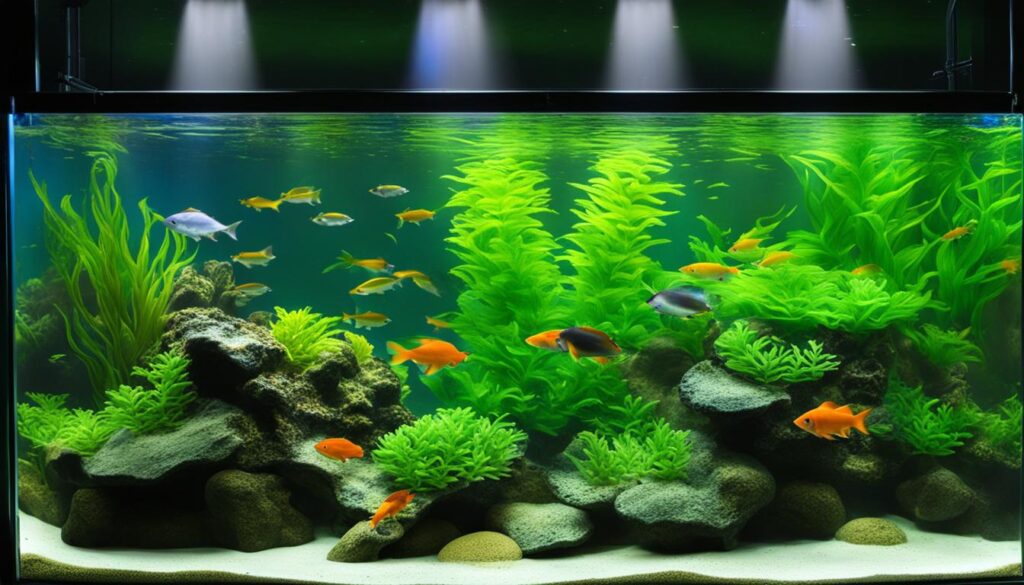
| Frequency | Description | |
|---|---|---|
| Water testing | Weekly | Test water for ammonia, nitrite, and nitrate levels to ensure they are within acceptable ranges. |
| Water changes | Bi-weekly | Replace a portion of the aquarium water with clean, dechlorinated water to dilute toxins and maintain stable water conditions. |
| Fish feeding | Daily | Feed fish an appropriate diet and avoid overfeeding to prevent excess waste production. |
| Tank maintenance | Monthly | Clean filters, remove debris, and ensure proper water flow to maintain optimal conditions. |
Conclusion
Cycling an aquarium is a crucial step in creating a healthy and stable environment for your fish. By employing natural methods such as fishless cycling, fish-in cycling, or cycling with plants, beginners can establish a biologically safe tank for their aquatic friends. These methods allow the introduction of nitrifying bacteria, which play a vital role in converting harmful substances such as ammonia and nitrite into less toxic nitrate.
Regular monitoring of water parameters, such as ammonia, nitrite, and nitrate levels, is essential for maintaining a cycled aquarium. This ensures that the beneficial bacteria are functioning optimally and the water quality remains suitable for your fish. Additionally, proper aquarium maintenance, including regular water changes and cleaning of filters, helps to sustain the balance of the ecosystem.
Taking care of your fish involves more than just cycling the aquarium. Providing the right conditions, such as appropriate tank size, suitable water temperature, and a balanced diet, is crucial for their overall well-being. It is important to research the specific requirements of your fish species and ensure that their needs are met for optimal health.
In conclusion, natural cycling methods, combined with regular monitoring and proper fish care, are key elements in maintaining a thriving aquarium. By implementing these techniques, you can enjoy a beautiful and healthy aquatic environment while ensuring the well-being of your fish.
FAQ
What is aquarium cycling?
Aquarium cycling is the process of creating a biologically safe environment for fish in a new tank. It involves introducing nitrifying bacteria into the aquarium to regulate the nitrogen cycle, which converts ammonia to nitrite and then to nitrate.
Why is aquarium cycling necessary?
Aquarium cycling is necessary to maintain water quality and provide a healthy environment for fish. Nitrifying bacteria in the biofilters of the aquarium convert toxic ammonia produced by fish waste into less harmful substances. Without proper cycling, ammonia levels can build up and harm the fish, leading to New Tank Syndrome.
How long does aquarium cycling take?
The duration of aquarium cycling can vary, but it generally takes around four to eight weeks. Factors such as tank size, water pH, and temperature can affect the cycling process.
What are the steps to cycle an aquarium without fish?
The steps to cycle an aquarium without fish are as follows: set up the tank’s components, check the water’s pH, add ammonia, monitor ammonia and nitrite levels, check nitrate levels, and introduce fish gradually once the cycling process is complete.
What are the steps to cycle an aquarium with fish?
The steps to cycle an aquarium with fish are as follows: set up the tank’s components, introduce a small number of hardy fish, feed them sparingly, perform frequent water changes, use test kits to monitor toxin levels, and gradually add more fish once toxin levels are near zero.
What are the steps to cycle an aquarium with plants?
The steps to cycle an aquarium with plants are as follows: set up the tank’s components, add live aquarium plants, provide good lighting and substrate for plant growth, test the water for ammonia and nitrite levels, and add fish gradually once toxin levels are near zero.
How do I maintain a cycled aquarium?
To maintain a cycled aquarium, regularly test water parameters for ammonia, nitrite, and nitrate levels. Perform periodic water changes to maintain water parameters, properly feed the fish, and conduct regular tank maintenance, such as cleaning filters and removing debris.
What are some natural ways to cycle an aquarium?
Natural ways to cycle an aquarium include fishless cycling, fish-in cycling, and cycling with plants. These methods ensure a proper balance of nitrifying bacteria and create a biologically safe environment for fish.
